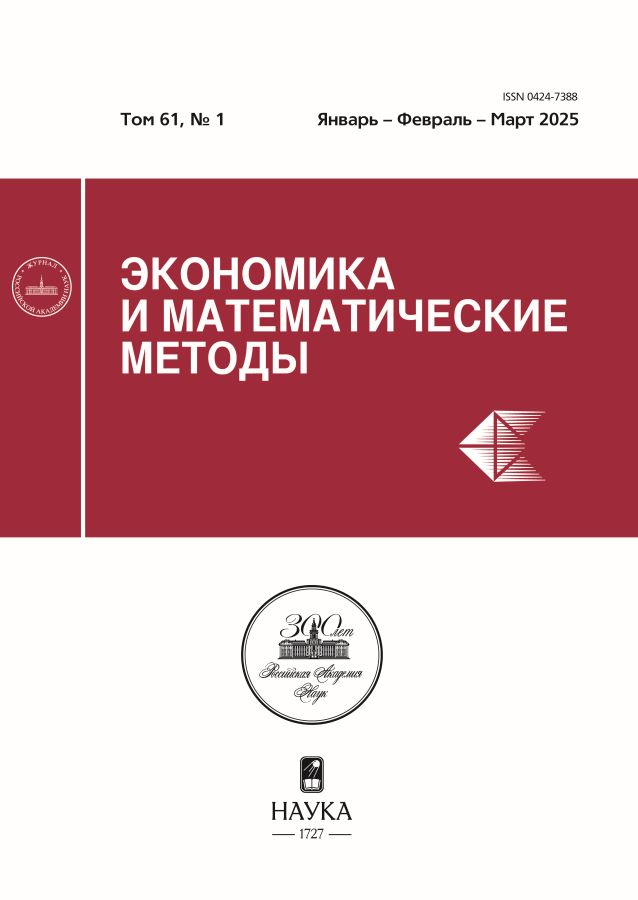Dynamic model of economic growth including the delay between the formation and use of human capital
- Authors: Kilmatov T.R.1
-
Affiliations:
- Marine State University named after admiral G. I. Nevelskoy, Far Eastern Federal University
- Issue: Vol 61, No 1 (2025)
- Pages: 125-128
- Section: Mathematical analysis of economic models
- URL: https://jdigitaldiagnostics.com/0424-7388/article/view/682167
- DOI: https://doi.org/10.31857/S0424738825010122
- ID: 682167
Cite item
Abstract
Following the macroeconomic dynamic models of the Solow type and taking into account the accumulated human capital the mathematical model is constructed. The model additionally takes into account the time lag between the formation of human capital (time of study) and its entry into the labor market. This means that the human capital participating in the economy at the present time was formed in the previous period. The dynamic model contains a differential equation with a deviating argument to simulate the time lag. Particular analytical stationary solutions in the approximation of a small parameter are constructed. The analyses of analytical solutions are carried out. There is model dependence between time lag formation — involvement of human capital and the intensive economic growth rates parameters. An interesting effect is noted: the economic agents with outstripping rates of population growth have worse intensive indicators of human capital formation (all other things being equal). At the same time economic agents with a higher level of technology have an advantage in accumulating human capital. As a consequence, the studied time delay may be a divergent factor in the rates of technological development between developed and poor countries. There is an accelerated population growth in developing countries and at the same time slow technological progress.
Full Text
About the authors
T. R. Kilmatov
Marine State University named after admiral G. I. Nevelskoy, Far Eastern Federal University
Author for correspondence.
Email: talgat_k@mail.ru
Russian Federation, Vladivostok
References
- Бекларян Л. А. (2007). Введение в теорию функционально-дифференциальных уравнений. Групповой подход. М.: Факториал Пресс. 288 с. [Beklaryan L. A. (2007). The introduction to the theory of functional differential equations. Group approach. Moscow: Factorial Press. 288 p. (in Russian).]
- Кильматов Т. Р. (2013). Временной лаг как фактор потери устойчивости экономической системы // Экономика и математические методы. Т. 49. № 3. С. 120–122. [Kilmatov T. R. (2013). Time lag and the instability of a business system. Economics and Mathematical Methods, 49, 3, 120–122 (in Russian).]
- Эльсцгольц Л. Э., Норкин С. Б. (1971). Введение в теорию дифференциальных уравнений с отклоняющимся аргументом. М.: Наука. 296 с. [Elscgolc L. E., Norkin S. B. (1971). The introduction to the theory of differential equations with deviating argument. Moscow: Nauka. 296 p. (in Russian).]
- Bellman R. (1949). On the existence and boundedness of solutions differential-difference equations. Annals of Mathematics, 50, 2, 347–355. doi: 10.2307/1969460
- Lucas R. E. (1988). On the mechanics of economic development. Journal of Monetary Economics, 22, 1, 3–42.
- Mankiw G., Romer D., Weil D. (1992). Contribution to the empirics of economic growth. The Quarterly Journal of Economics, 107, 2, 407–437. doi: 10.2307/2118477
- Romer P. (1989). Human capital and growth: Theory and evidence. NBER Working paper, 3173. doi: 10.3386/w3173
- Romer P. (1990). Endogenous technological change. Journal of Political Economy, 98, 5, 71–102.
- Solow R. M. (1956). Contribution to the Theory of Economic Growth. The Quarterly Journal of Economics, 70, 1, 65–94.
Supplementary files










